
llamabot
Pythonic class-based interface to LLMs
Stars: 132
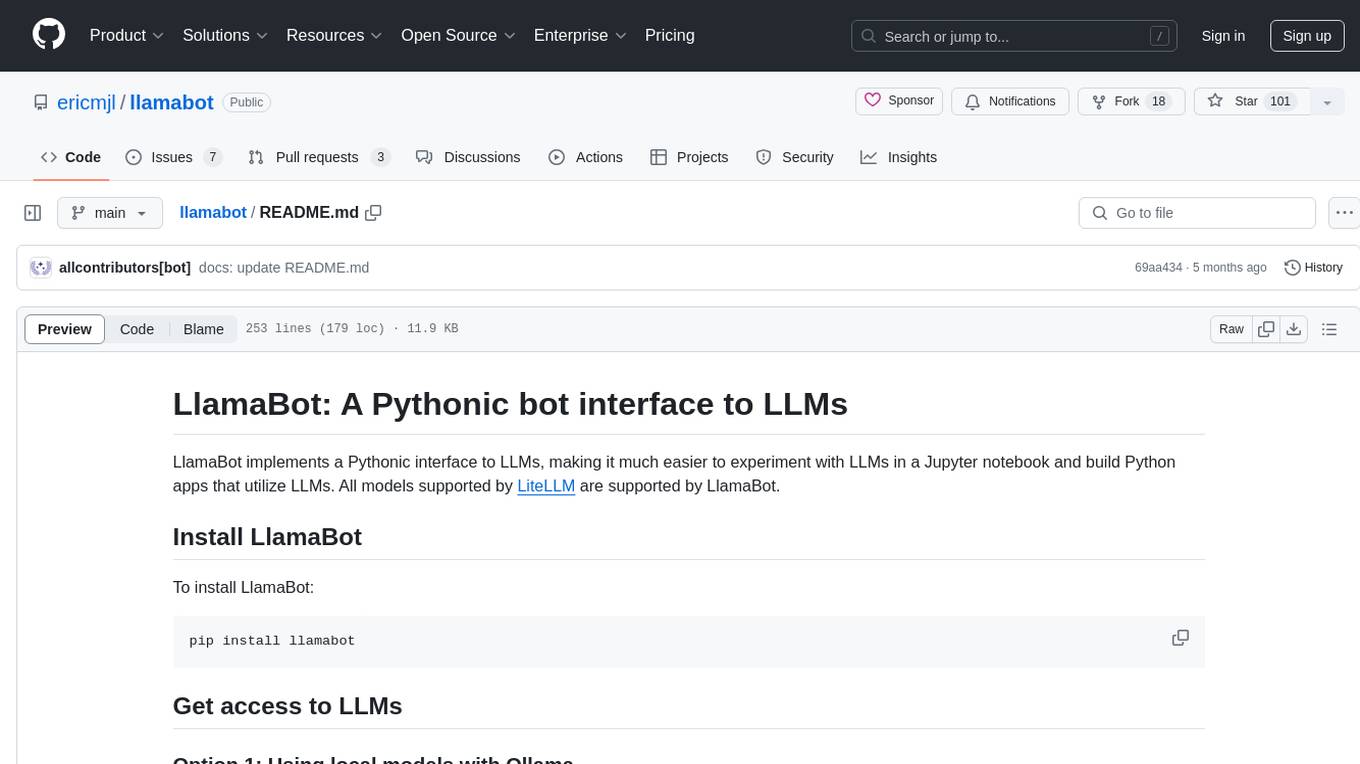
LlamaBot is a Pythonic bot interface to Large Language Models (LLMs), providing an easy way to experiment with LLMs in Jupyter notebooks and build Python apps utilizing LLMs. It supports all models available in LiteLLM. Users can access LLMs either through local models with Ollama or by using API providers like OpenAI and Mistral. LlamaBot offers different bot interfaces like SimpleBot, ChatBot, QueryBot, and ImageBot for various tasks such as rephrasing text, maintaining chat history, querying documents, and generating images. The tool also includes CLI demos showcasing its capabilities and supports contributions for new features and bug reports from the community.
README:
LlamaBot implements a Pythonic interface to LLMs, making it much easier to experiment with LLMs in a Jupyter notebook and build Python apps that utilize LLMs. All models supported by LiteLLM are supported by LlamaBot.
To install LlamaBot:
pip install llamabot==0.10.8LlamaBot supports using local models through Ollama. To do so, head over to the Ollama website and install Ollama. Then follow the instructions below.
If you have an OpenAI API key, then configure LlamaBot to use the API key by running:
export OPENAI_API_KEY="sk-your1api2key3goes4here"If you have a Mistral API key, then configure LlamaBot to use the API key by running:
export MISTRAL_API_KEY="your-api-key-goes-here"Other API providers will usually specify an environment variable to set. If you have an API key, then set the environment variable accordingly.
The simplest use case of LlamaBot
is to create a SimpleBot that keeps no record of chat history.
This is effectively the same as a stateless function
that you program with natural language instructions rather than code.
This is useful for prompt experimentation,
or for creating simple bots that are preconditioned on an instruction to handle texts
and are then called upon repeatedly with different texts.
For example, to create a Bot that explains a given chunk of text like Richard Feynman would:
from llamabot import SimpleBot
system_prompt = "You are Richard Feynman. You will be given a difficult concept, and your task is to explain it back."
feynman = SimpleBot(
system_prompt,
model_name="gpt-3.5-turbo"
)For using GPT, you need to have the OPENAI_API_KEY environment variable configured. If you want to use SimpleBot with a local Ollama model, check out this example
Now, feynman is callable on any arbitrary chunk of text and will return a rephrasing of that text in Richard Feynman's style (or more accurately, according to the style prescribed by the system_prompt).
For example:
prompt = """
Enzyme function annotation is a fundamental challenge, and numerous computational tools have been developed.
However, most of these tools cannot accurately predict functional annotations,
such as enzyme commission (EC) number,
for less-studied proteins or those with previously uncharacterized functions or multiple activities.
We present a machine learning algorithm named CLEAN (contrastive learning–enabled enzyme annotation)
to assign EC numbers to enzymes with better accuracy, reliability,
and sensitivity compared with the state-of-the-art tool BLASTp.
The contrastive learning framework empowers CLEAN to confidently (i) annotate understudied enzymes,
(ii) correct mislabeled enzymes, and (iii) identify promiscuous enzymes with two or more EC numbers—functions
that we demonstrate by systematic in silico and in vitro experiments.
We anticipate that this tool will be widely used for predicting the functions of uncharacterized enzymes,
thereby advancing many fields, such as genomics, synthetic biology, and biocatalysis.
"""
feynman(prompt)This will return something that looks like:
Alright, let's break this down.
Enzymes are like little biological machines that help speed up chemical reactions in our
bodies. Each enzyme has a specific job, or function, and we use something called an
Enzyme Commission (EC) number to categorize these functions.
Now, the problem is that we don't always know what function an enzyme has, especially if
it's a less-studied or new enzyme. This is where computational tools come in. They try
to predict the function of these enzymes, but they often struggle to do so accurately.
So, the folks here have developed a new tool called CLEAN, which stands for contrastive
learning–enabled enzyme annotation. This tool uses a machine learning algorithm, which
is a type of artificial intelligence that learns from data to make predictions or
decisions.
CLEAN uses a method called contrastive learning. Imagine you have a bunch of pictures of
cats and dogs, and you want to teach a machine to tell the difference. You'd show it
pairs of pictures, some of the same animal (two cats or two dogs) and some of different
animals (a cat and a dog). The machine would learn to tell the difference by contrasting
the features of the two pictures. That's the basic idea behind contrastive learning.
CLEAN uses this method to predict the EC numbers of enzymes more accurately than
previous tools. It can confidently annotate understudied enzymes, correct mislabeled
enzymes, and even identify enzymes that have more than one function.
The creators of CLEAN have tested it with both computer simulations and lab experiments,
and they believe it will be a valuable tool for predicting the functions of unknown
enzymes. This could have big implications for fields like genomics, synthetic biology,
and biocatalysis, which all rely on understanding how enzymes work.
If you want to use an Ollama model hosted locally, then you would use the following syntax:
from llamabot import SimpleBot
system_prompt = "You are Richard Feynman. You will be given a difficult concept, and your task is to explain it back."
bot = SimpleBot(
system_prompt,
model_name="ollama_chat/llama2:13b"
)Simply specify the model_name keyword argument following the <provider>/<model name> format. For example:
-
ollama_chat/as the prefix, and - a model name from the Ollama library of models
All you need to do is make sure Ollama is running locally;
see the Ollama documentation for more details.
(The same can be done for the ChatBot and QueryBot classes below!)
The model_name argument is optional. If you don't provide it, Llamabot will try to use the default model. You can configure that in the DEFAULT_LANGUAGE_MODEL environment variable.
To experiment with a Chat Bot in the Jupyter Notebook, we also provide the ChatBot interface. This interface automagically keeps track of chat history for as long as your Jupyter session is alive. Doing so allows you to use your own local Jupyter Notebook as a chat interface.
For example:
from llamabot import ChatBot
system_prompt="You are Richard Feynman. You will be given a difficult concept, and your task is to explain it back."
feynman = ChatBot(
system_prompt,
session_name="feynman_chat",
# Optional:
# model_name="gpt-3.5-turbo"
# or
# model_name="ollama_chat/mistral"
)For more explanation about the model_name, see the examples with SimpleBot.
Now, that you have a ChatBot instance, you can start a conversation with it.
prompt = """
Enzyme function annotation is a fundamental challenge, and numerous computational tools have been developed.
However, most of these tools cannot accurately predict functional annotations,
such as enzyme commission (EC) number,
for less-studied proteins or those with previously uncharacterized functions or multiple activities.
We present a machine learning algorithm named CLEAN (contrastive learning–enabled enzyme annotation)
to assign EC numbers to enzymes with better accuracy, reliability,
and sensitivity compared with the state-of-the-art tool BLASTp.
The contrastive learning framework empowers CLEAN to confidently (i) annotate understudied enzymes,
(ii) correct mislabeled enzymes, and (iii) identify promiscuous enzymes with two or more EC numbers—functions
that we demonstrate by systematic in silico and in vitro experiments.
We anticipate that this tool will be widely used for predicting the functions of uncharacterized enzymes,
thereby advancing many fields, such as genomics, synthetic biology, and biocatalysis.
"""
feynman(prompt)With the chat history available, you can ask a follow-up question:
feynman("Is there a simpler way to rephrase the text such that a high schooler would understand it?")And your bot will work with the chat history to respond.
The final bot provided is a QueryBot. This bot lets you query a collection of documents. To use it, you have two options:
- Pass in a list of paths to text files and make Llamabot create a new collection for them, or
- Pass in the
collection_nameof a previously instantiatedQueryBotmodel. (This will load the previously-computed text index into memory.)
An illustrative example creating a new collection:
from llamabot import QueryBot
from pathlib import Path
bot = QueryBot(
system_prompt="You are an expert on Eric Ma's blog.",
collection_name="eric_ma_blog",
document_paths=[
Path("/path/to/blog/post1.txt"),
Path("/path/to/blog/post2.txt"),
...,
],
# Optional:
# model_name="gpt-3.5-turbo"
# or
# model_name="ollama_chat/mistral"
) # This creates a new embedding for my blog text.
result = bot("Do you have any advice for me on career development?")An illustrative example using an already existing collection:
from llamabot import QueryBot
bot = QueryBot(
system_prompt="You are an expert on Eric Ma's blog",
collection_name="eric_ma_blog",
# Optional:
# model_name="gpt-3.5-turbo"
# or
# model_name="ollama_chat/mistral"
) # This loads my previously-embedded blog text.
result = bot("Do you have any advice for me on career development?")For more explanation about the model_name, see the examples with SimpleBot.
With the release of the OpenAI API updates, as long as you have an OpenAI API key, you can generate images with LlamaBot:
from llamabot import ImageBot
bot = ImageBot()
# Within a Jupyter notebook:
url = bot("A painting of a dog.")
# Or within a Python script
filepath = bot("A painting of a dog.")
# Now, you can do whatever you need with the url or file path.If you're in a Jupyter Notebook, you'll see the image show up magically as part of the output cell as well.
Automagically record your prompt experimentation locally on your system
by using llamabot's Experiment context manager:
from llamabot import Experiment, prompt, metric
@prompt
def sysprompt():
"""You are a funny llama."""
@prompt
def joke_about(topic):
"""Tell me a joke about {{ topic }}."""
@metric
def response_length(response) -> int:
return len(response.content)
with Experiment(name="llama_jokes") as exp:
# You would have written this outside of the context manager anyways!
bot = SimpleBot(sysprompt(), model_name="gpt-4o")
response = bot(joke_about("cars"))
_ = response_length(response)And now they will be viewable in the locally-stored message logs:
Llamabot comes with CLI demos of what can be built with it and a bit of supporting code.
Here is one where I expose a chatbot directly at the command line using llamabot chat:
And here is another one where llamabot is used as part of the backend of a CLI app
to chat with one's Zotero library using llamabot zotero chat:
And finally, here is one where I use llamabot's SimpleBot to create a bot
that automatically writes commit messages for me.
LlamaBot uses a caching mechanism to improve performance and reduce unnecessary API calls. By default, all cache entries expire after 1 day (86400 seconds). This behavior is implemented using the diskcache library.
The cache is automatically configured when you use any of the bot classes (SimpleBot, ChatBot, or QueryBot). You don't need to set up the cache manually.
The default cache directory is located at:
~/.llamabot/cache
The cache timeout can be configured using the LLAMABOT_CACHE_TIMEOUT environment variable. By default, the cache timeout is set to 1 day (86400 seconds). To customize the cache timeout, set the LLAMABOT_CACHE_TIMEOUT environment variable to the desired value in seconds. For example:
export LLAMABOT_CACHE_TIMEOUT=3600
This will set the cache timeout to 1 hour (3600 seconds).
New features are welcome! These are early and exciting days for users of large language models. Our development goals are to keep the project as simple as possible. Features requests that come with a pull request will be prioritized; the simpler the implementation of a feature (in terms of maintenance burden), the more likely it will be approved.
Please submit a bug report using the issue tracker.
Please use the issue tracker on GitHub.
|
Rena Lu 💻 |
andrew giessel 🤔 🎨 💻 |
Aidan Brewis 💻 |
Eric Ma 🤔 🎨 💻 |
Mark Harrison 🤔 |
reka 📖 💻 |
anujsinha3 �� 📖 |
|
Elliot Salisbury 📖 |
Ethan Fricker, PhD 📖 |
Ikko Eltociear Ashimine 📖 |
Amir Molavi 🚇 📖 |
For Tasks:
Click tags to check more tools for each tasksFor Jobs:
Alternative AI tools for llamabot
Similar Open Source Tools

llamabot
LlamaBot is a Pythonic bot interface to Large Language Models (LLMs), providing an easy way to experiment with LLMs in Jupyter notebooks and build Python apps utilizing LLMs. It supports all models available in LiteLLM. Users can access LLMs either through local models with Ollama or by using API providers like OpenAI and Mistral. LlamaBot offers different bot interfaces like SimpleBot, ChatBot, QueryBot, and ImageBot for various tasks such as rephrasing text, maintaining chat history, querying documents, and generating images. The tool also includes CLI demos showcasing its capabilities and supports contributions for new features and bug reports from the community.
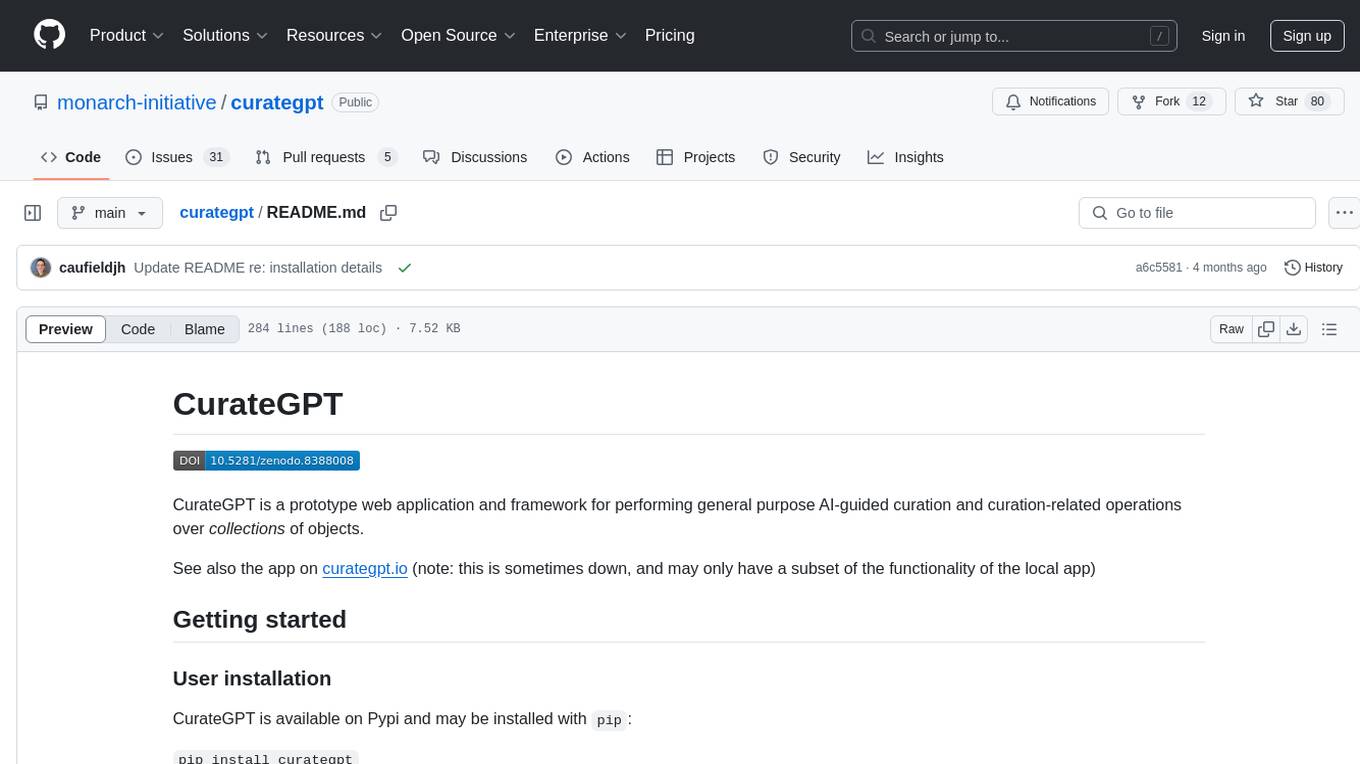
curategpt
CurateGPT is a prototype web application and framework designed for general purpose AI-guided curation and curation-related operations over collections of objects. It provides functionalities for loading example data, building indexes, interacting with knowledge bases, and performing tasks such as chatting with a knowledge base, querying Pubmed, interacting with a GitHub issue tracker, term autocompletion, and all-by-all comparisons. The tool is built to work best with the OpenAI gpt-4 model and OpenAI ada-text-embedding-002 for embedding, but also supports alternative models through a plugin architecture.
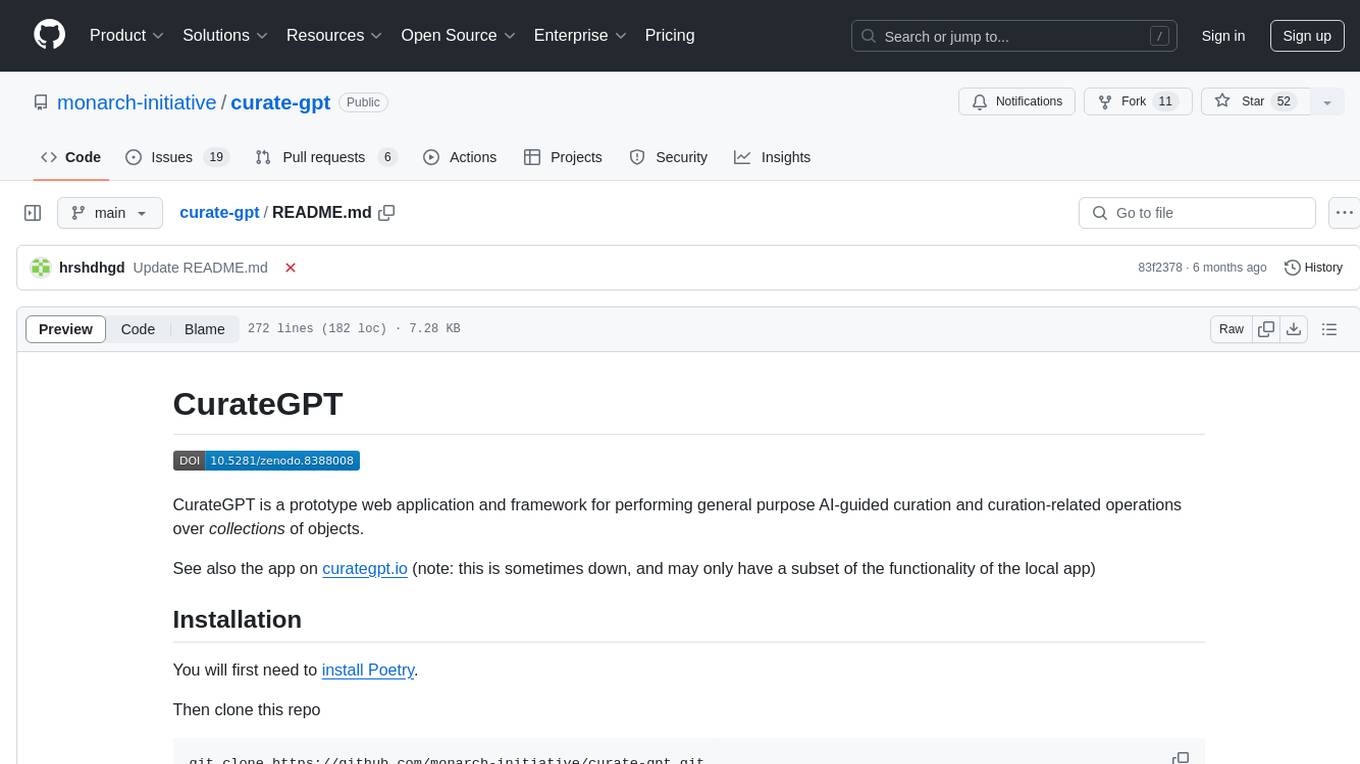
curate-gpt
CurateGPT is a prototype web application and framework for performing general purpose AI-guided curation and curation-related operations over collections of objects. It allows users to load JSON, YAML, or CSV data, build vector database indexes for ontologies, and interact with various data sources like GitHub, Google Drives, Google Sheets, and more. The tool supports ontology curation, knowledge base querying, term autocompletion, and all-by-all comparisons for objects in a collection.
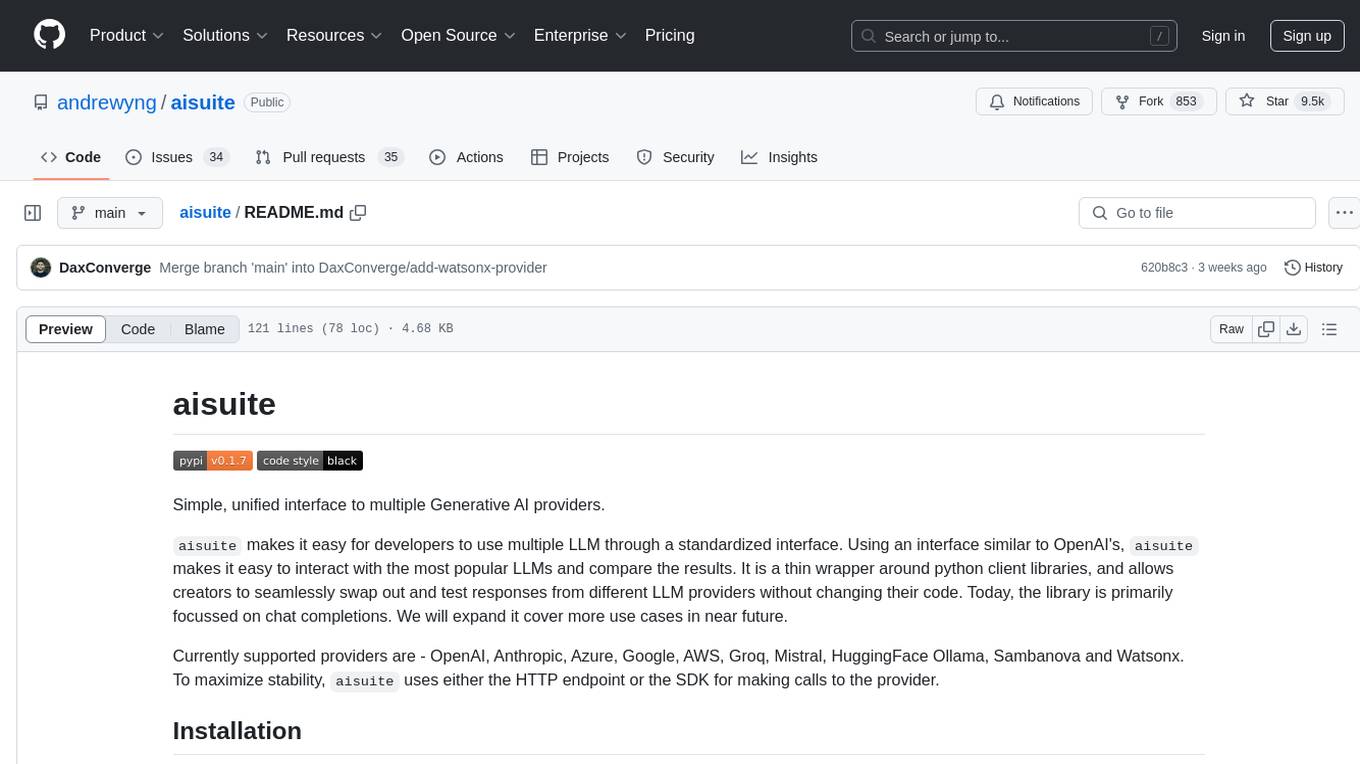
aisuite
Aisuite is a simple, unified interface to multiple Generative AI providers. It allows developers to easily interact with various Language Model (LLM) providers like OpenAI, Anthropic, Azure, Google, AWS, and more through a standardized interface. The library focuses on chat completions and provides a thin wrapper around python client libraries, enabling creators to test responses from different LLM providers without changing their code. Aisuite maximizes stability by using HTTP endpoints or SDKs for making calls to the providers. Users can install the base package or specific provider packages, set up API keys, and utilize the library to generate chat completion responses from different models.
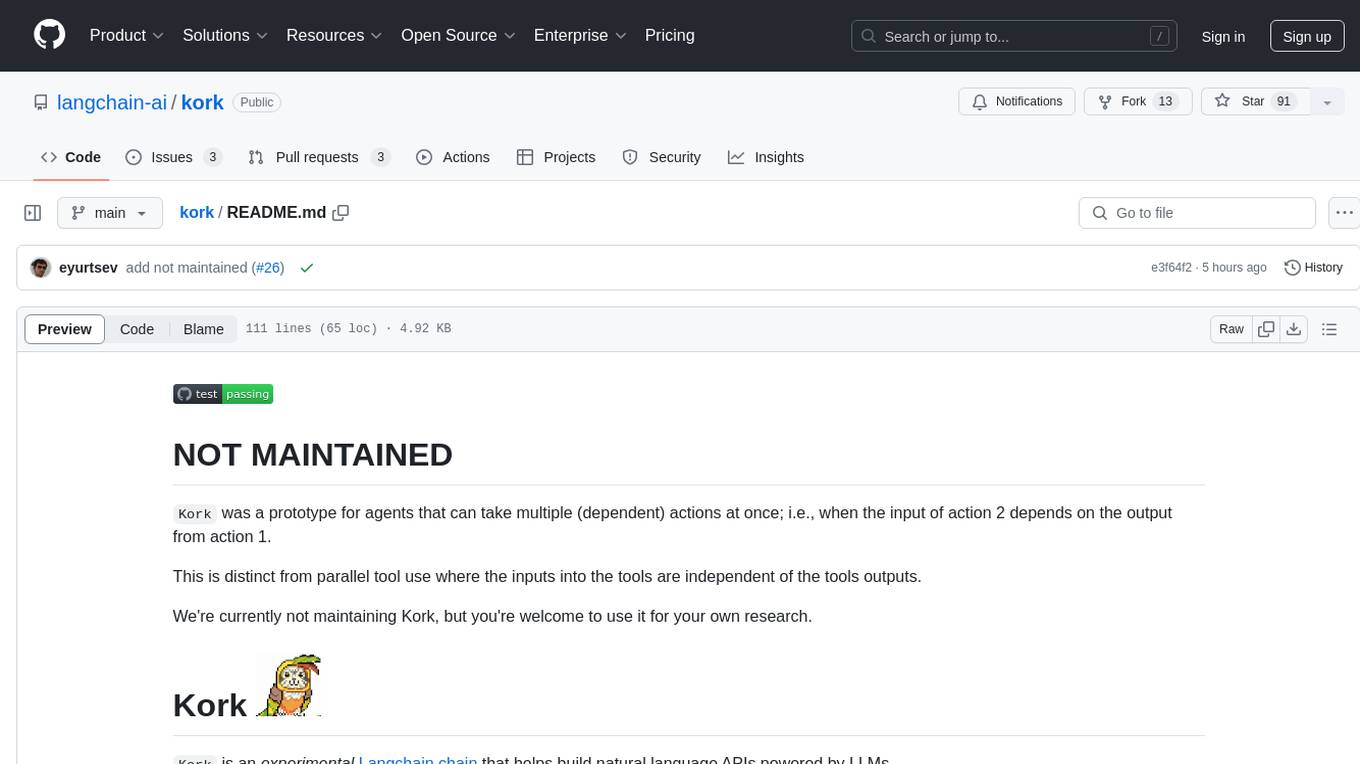
kork
Kork is an experimental Langchain chain that helps build natural language APIs powered by LLMs. It allows assembling a natural language API from python functions, generating a prompt for correct program writing, executing programs safely, and controlling the kind of programs LLMs can generate. The language is limited to variable declarations, function invocations, and arithmetic operations, ensuring predictability and safety in production settings.
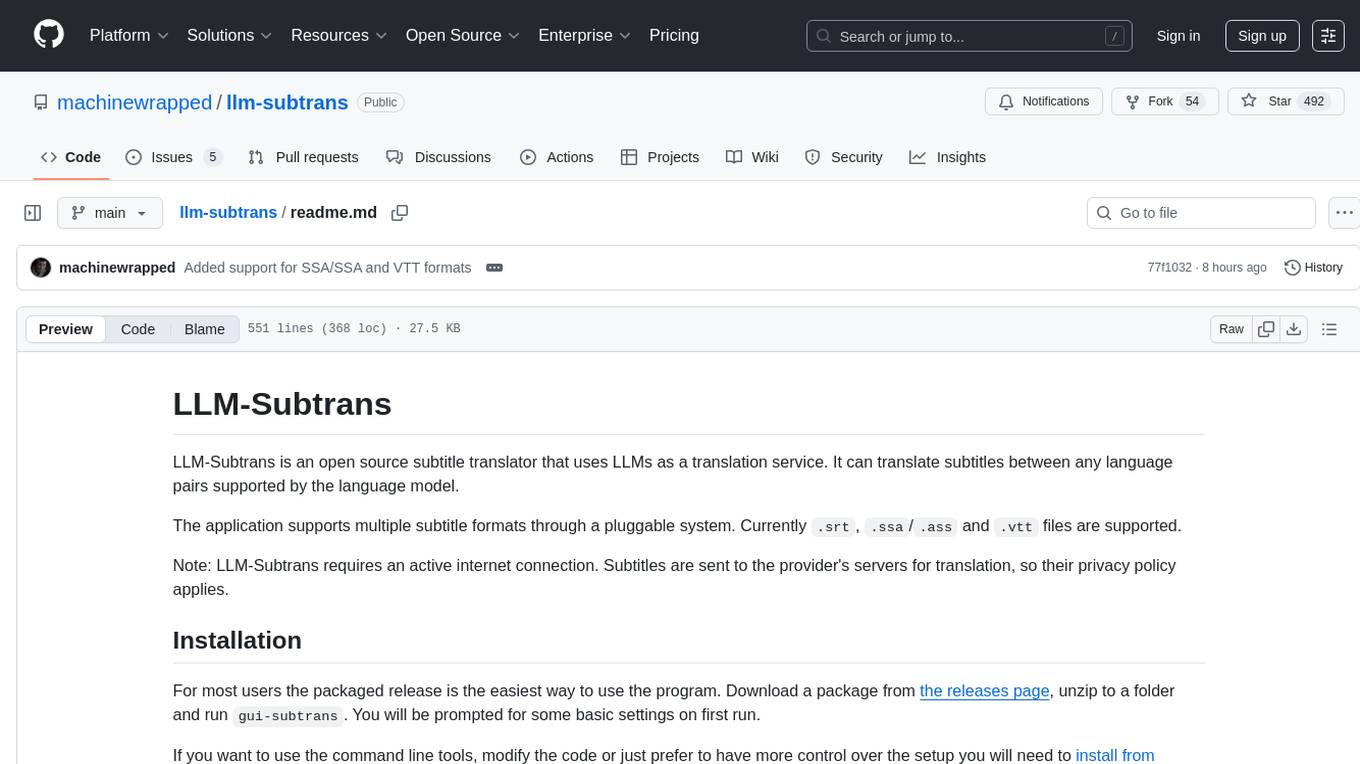
llm-subtrans
LLM-Subtrans is an open source subtitle translator that utilizes LLMs as a translation service. It supports translating subtitles between any language pairs supported by the language model. The application offers multiple subtitle formats support through a pluggable system, including .srt, .ssa/.ass, and .vtt files. Users can choose to use the packaged release for easy usage or install from source for more control over the setup. The tool requires an active internet connection as subtitles are sent to translation service providers' servers for translation.
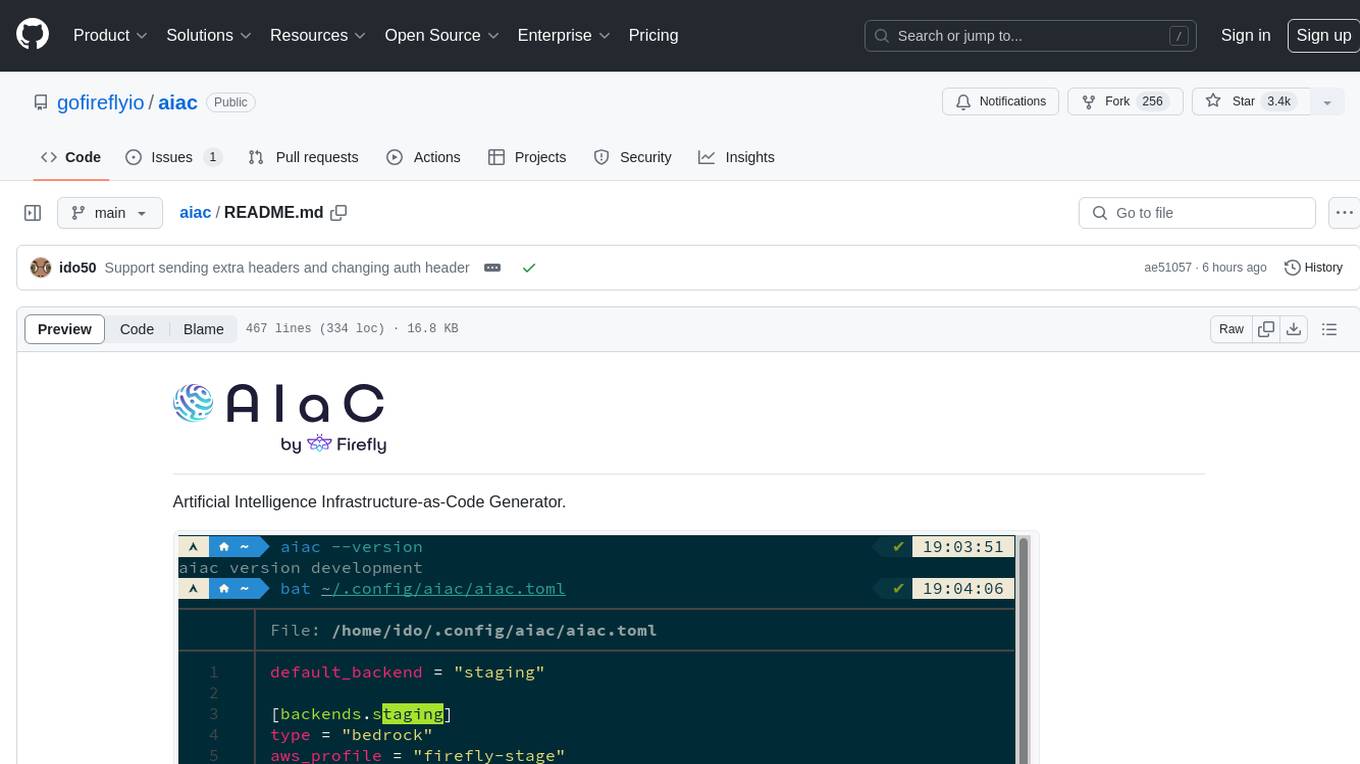
aiac
AIAC is a library and command line tool to generate Infrastructure as Code (IaC) templates, configurations, utilities, queries, and more via LLM providers such as OpenAI, Amazon Bedrock, and Ollama. Users can define multiple 'backends' targeting different LLM providers and environments using a simple configuration file. The tool allows users to ask a model to generate templates for different scenarios and composes an appropriate request to the selected provider, storing the resulting code to a file and/or printing it to standard output.
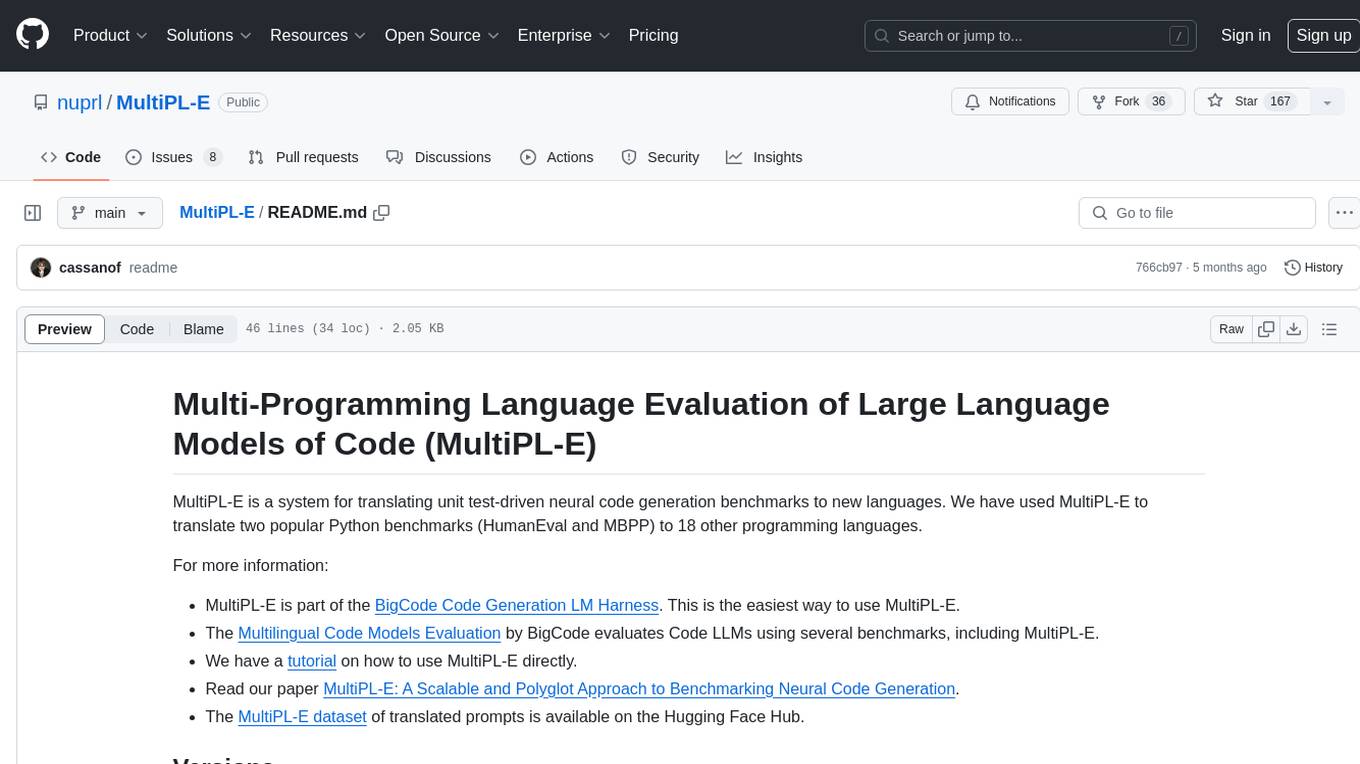
MultiPL-E
MultiPL-E is a system for translating unit test-driven neural code generation benchmarks to new languages. It is part of the BigCode Code Generation LM Harness and allows for evaluating Code LLMs using various benchmarks. The tool supports multiple versions with improvements and new language additions, providing a scalable and polyglot approach to benchmarking neural code generation. Users can access a tutorial for direct usage and explore the dataset of translated prompts on the Hugging Face Hub.
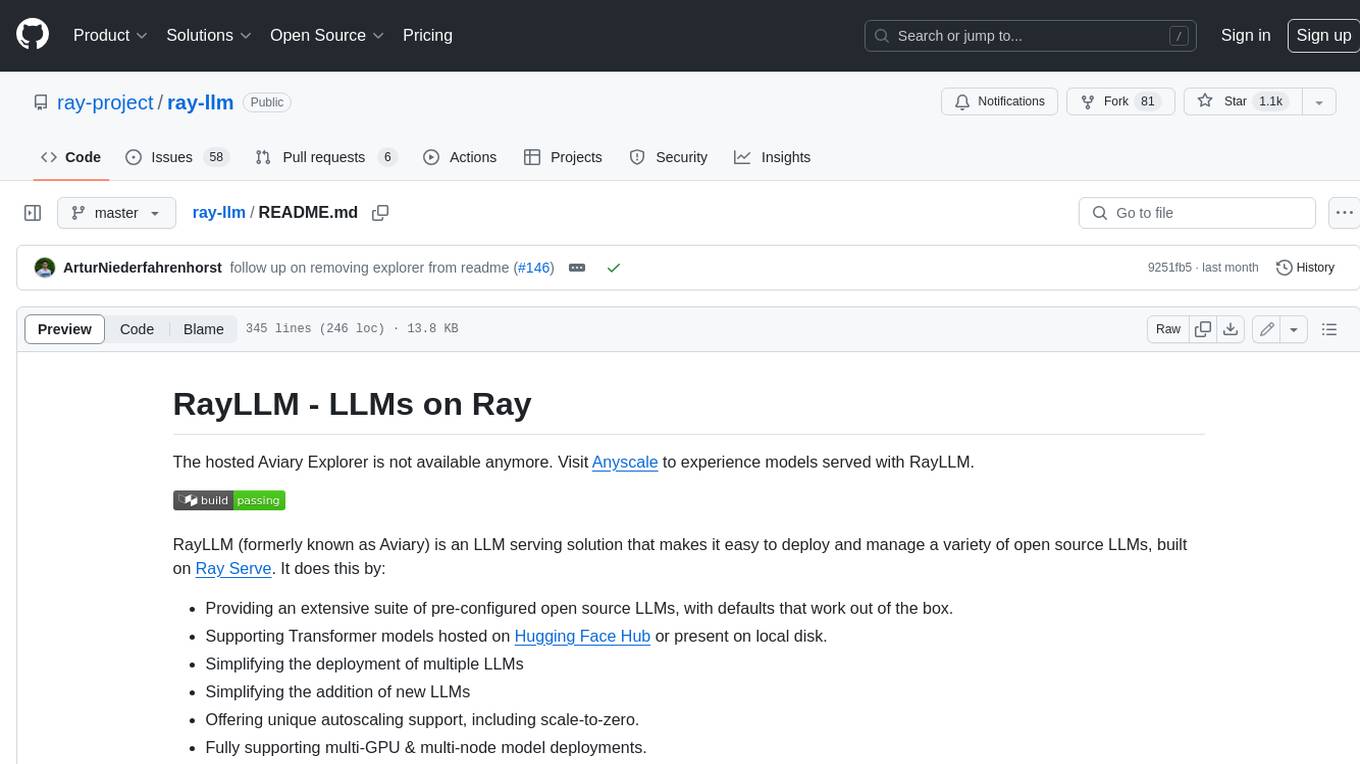
ray-llm
RayLLM (formerly known as Aviary) is an LLM serving solution that makes it easy to deploy and manage a variety of open source LLMs, built on Ray Serve. It provides an extensive suite of pre-configured open source LLMs, with defaults that work out of the box. RayLLM supports Transformer models hosted on Hugging Face Hub or present on local disk. It simplifies the deployment of multiple LLMs, the addition of new LLMs, and offers unique autoscaling support, including scale-to-zero. RayLLM fully supports multi-GPU & multi-node model deployments and offers high performance features like continuous batching, quantization and streaming. It provides a REST API that is similar to OpenAI's to make it easy to migrate and cross test them. RayLLM supports multiple LLM backends out of the box, including vLLM and TensorRT-LLM.
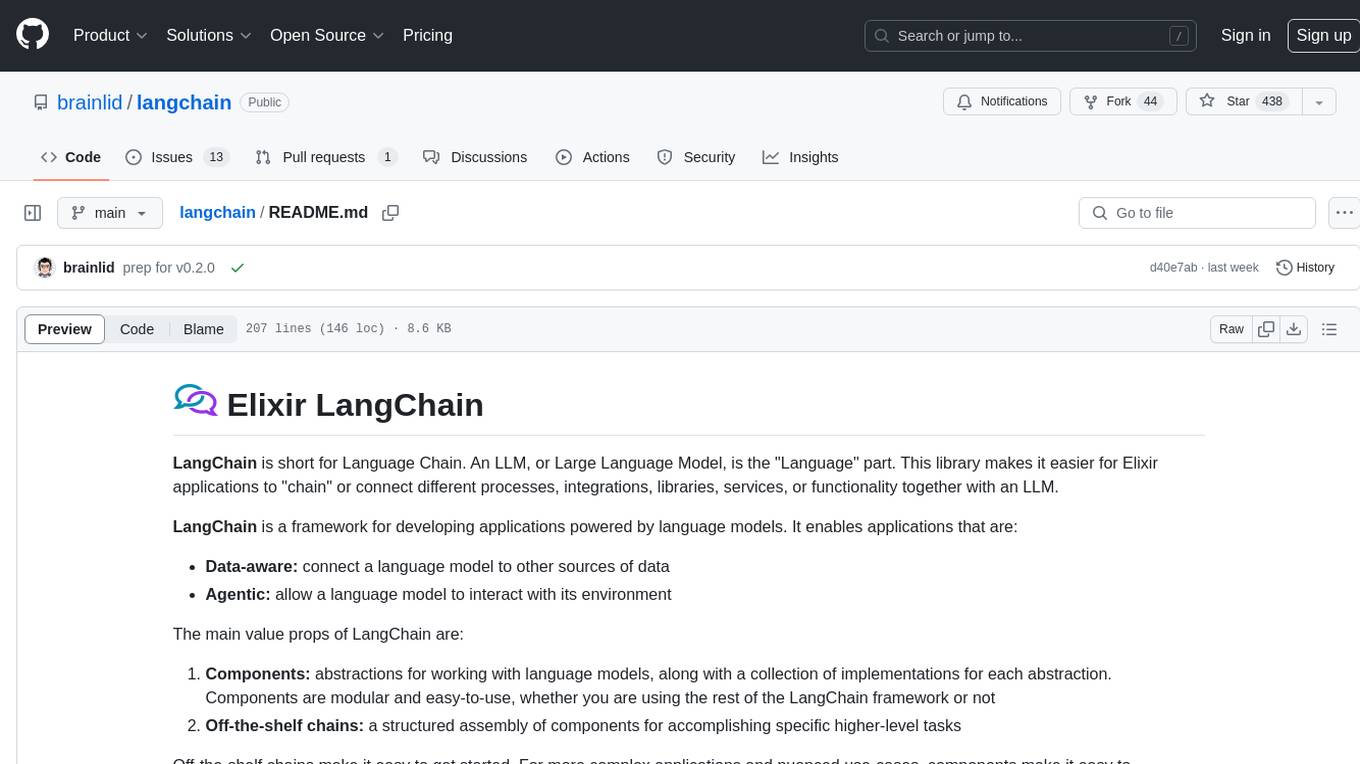
langchain
LangChain is a framework for developing Elixir applications powered by language models. It enables applications to connect language models to other data sources and interact with the environment. The library provides components for working with language models and off-the-shelf chains for specific tasks. It aims to assist in building applications that combine large language models with other sources of computation or knowledge. LangChain is written in Elixir and is not aimed for parity with the JavaScript and Python versions due to differences in programming paradigms and design choices. The library is designed to make it easy to integrate language models into applications and expose features, data, and functionality to the models.
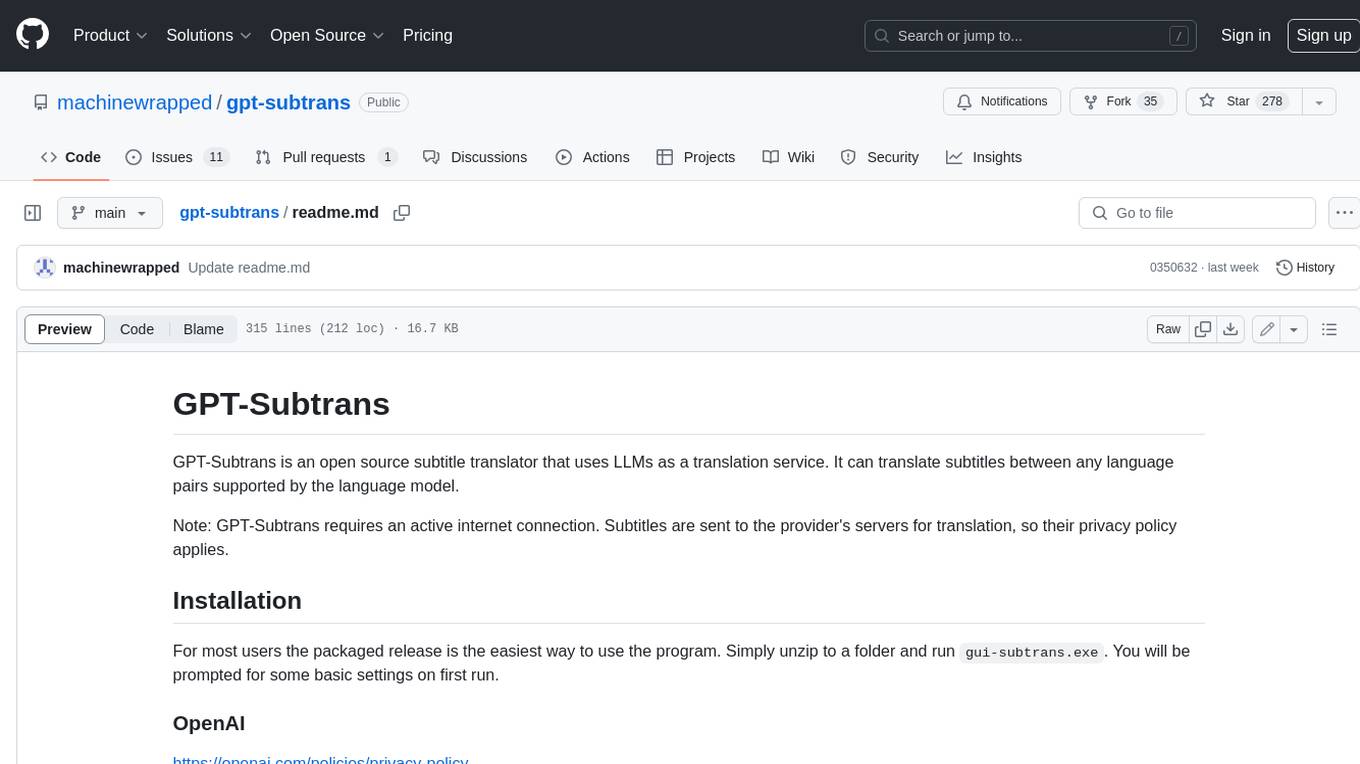
gpt-subtrans
GPT-Subtrans is an open-source subtitle translator that utilizes large language models (LLMs) as translation services. It supports translation between any language pairs that the language model supports. Note that GPT-Subtrans requires an active internet connection, as subtitles are sent to the provider's servers for translation, and their privacy policy applies.
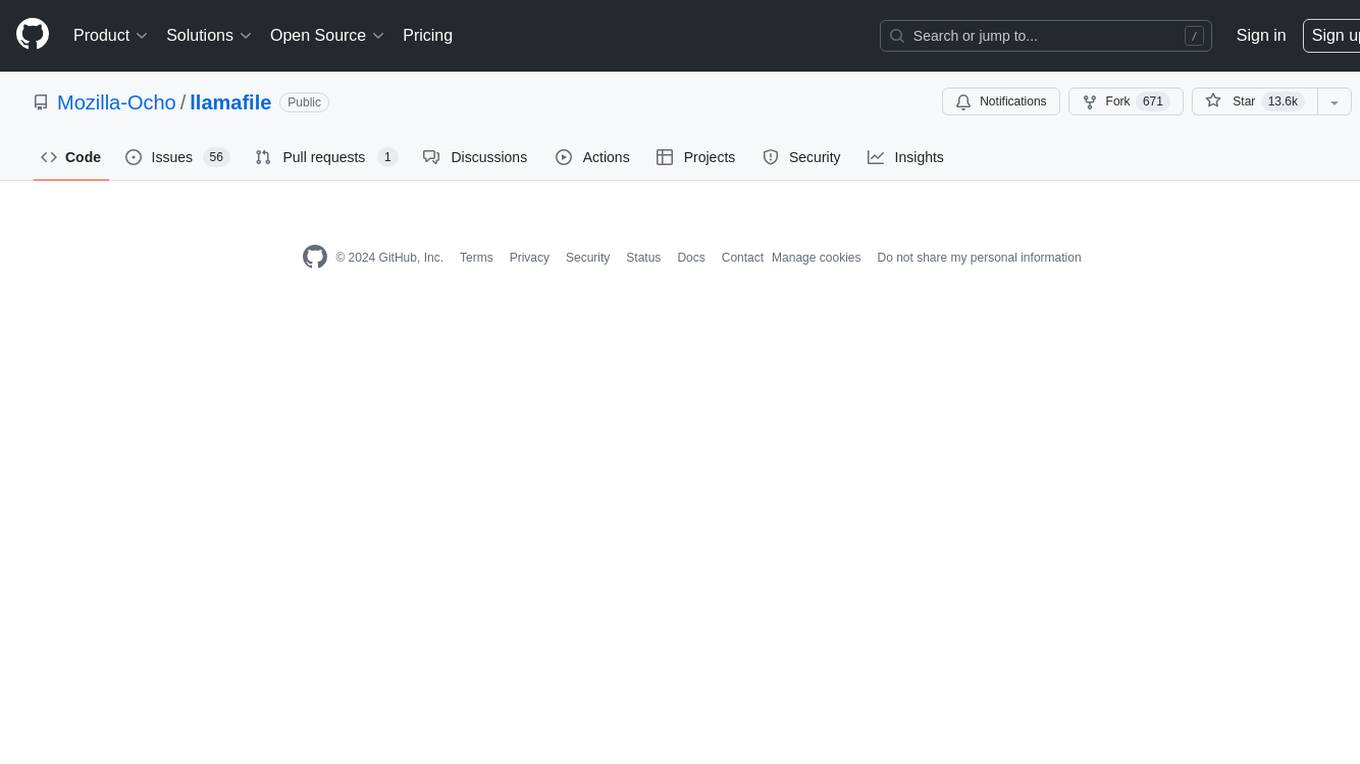
llamafile
llamafile is a tool that enables users to distribute and run Large Language Models (LLMs) with a single file. It combines llama.cpp with Cosmopolitan Libc to create a framework that simplifies the complexity of LLMs into a single-file executable called a 'llamafile'. Users can run these executable files locally on most computers without the need for installation, making open LLMs more accessible to developers and end users. llamafile also provides example llamafiles for various LLM models, allowing users to try out different LLMs locally. The tool supports multiple CPU microarchitectures, CPU architectures, and operating systems, making it versatile and easy to use.
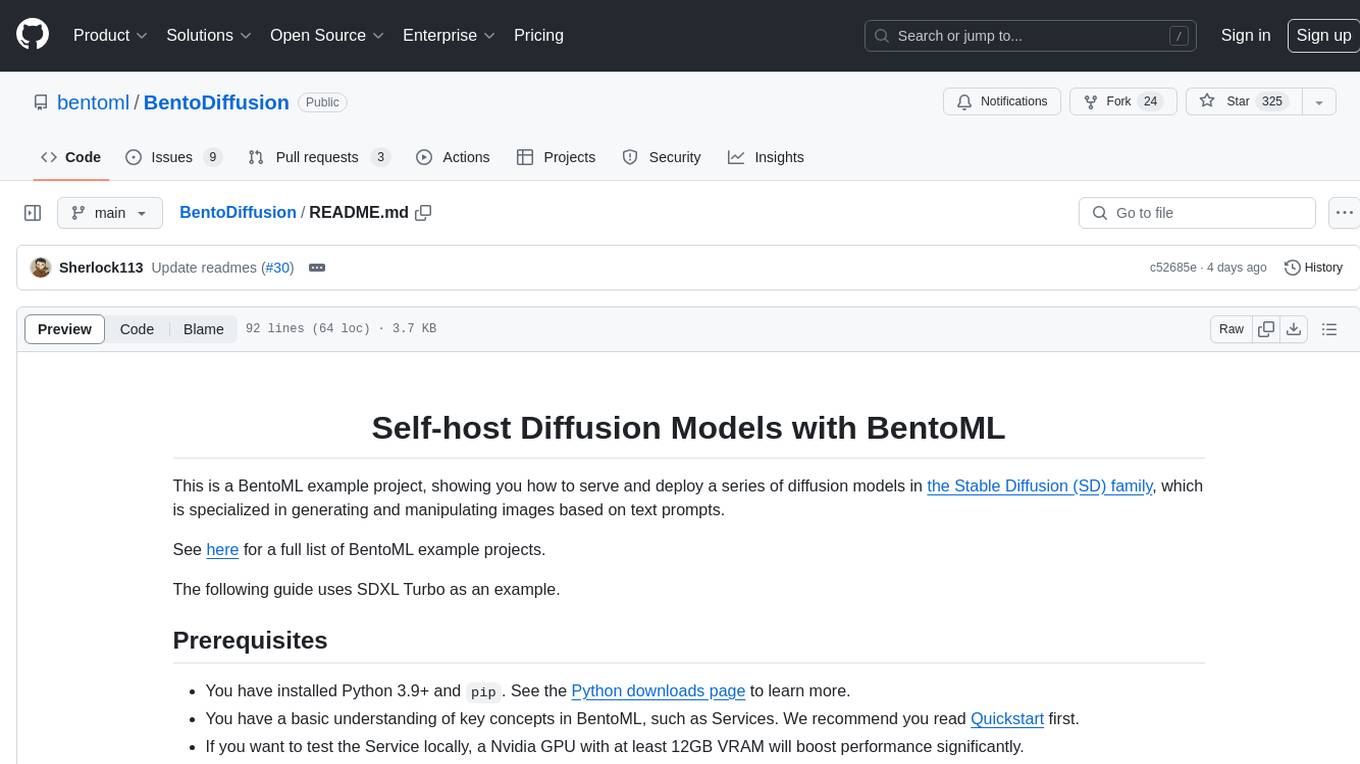
BentoDiffusion
BentoDiffusion is a BentoML example project that demonstrates how to serve and deploy diffusion models in the Stable Diffusion (SD) family. These models are specialized in generating and manipulating images based on text prompts. The project provides a guide on using SDXL Turbo as an example, along with instructions on prerequisites, installing dependencies, running the BentoML service, and deploying to BentoCloud. Users can interact with the deployed service using Swagger UI or other methods. Additionally, the project offers the option to choose from various diffusion models available in the repository for deployment.
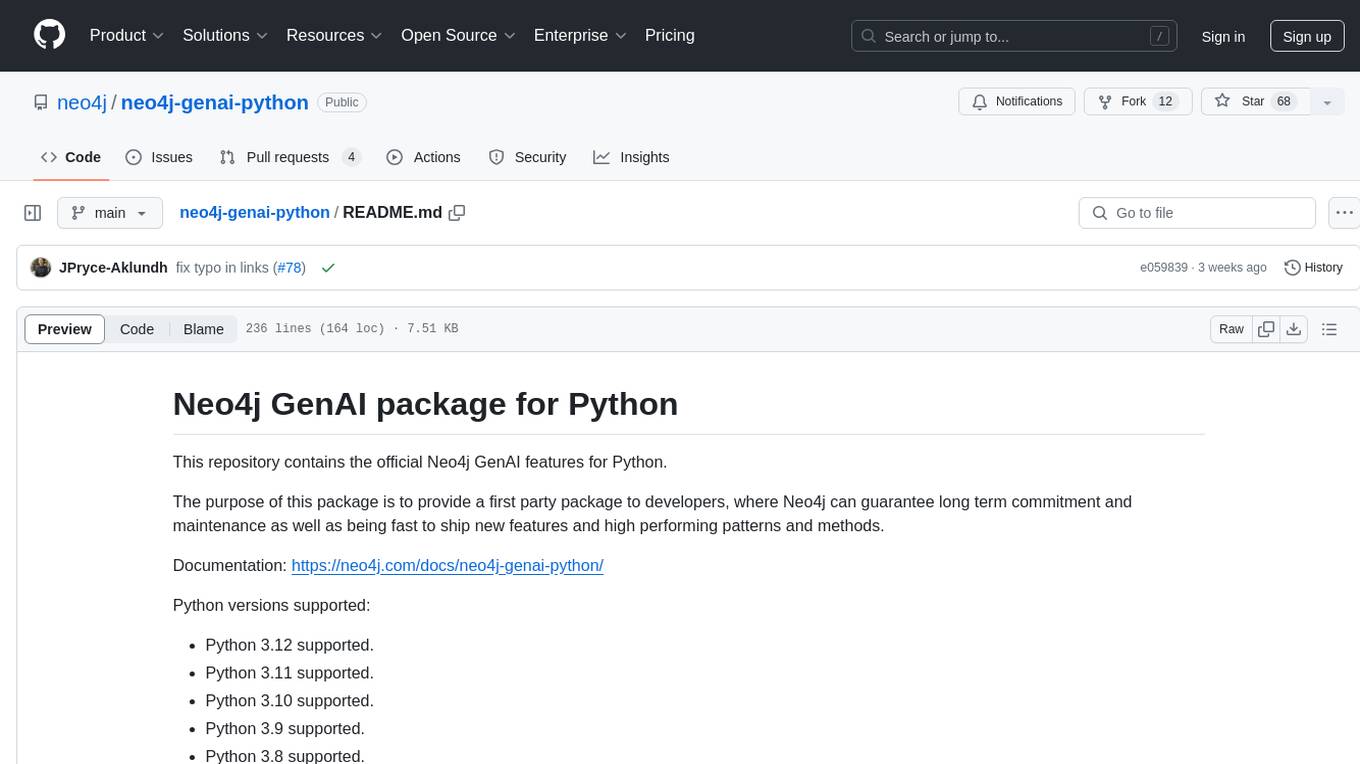
neo4j-genai-python
This repository contains the official Neo4j GenAI features for Python. The purpose of this package is to provide a first-party package to developers, where Neo4j can guarantee long-term commitment and maintenance as well as being fast to ship new features and high-performing patterns and methods.
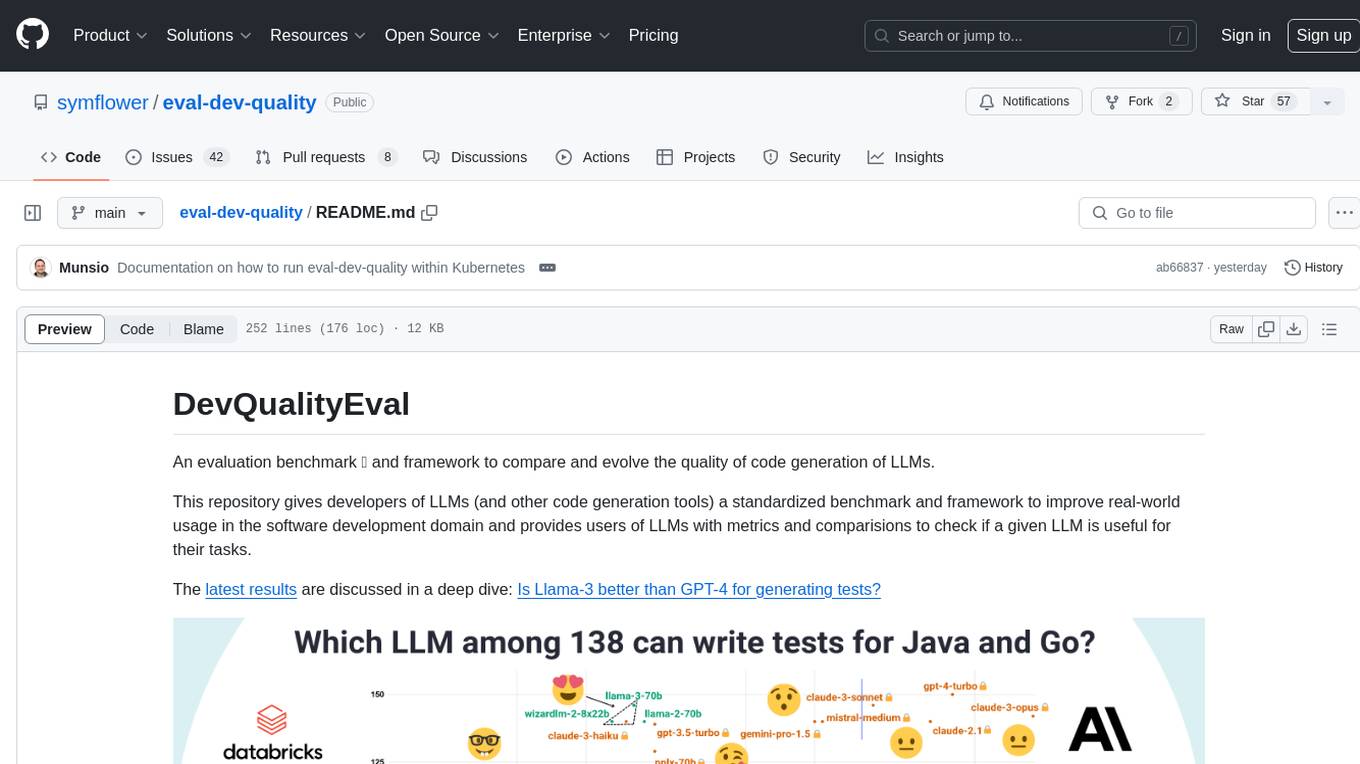
eval-dev-quality
DevQualityEval is an evaluation benchmark and framework designed to compare and improve the quality of code generation of Language Model Models (LLMs). It provides developers with a standardized benchmark to enhance real-world usage in software development and offers users metrics and comparisons to assess the usefulness of LLMs for their tasks. The tool evaluates LLMs' performance in solving software development tasks and measures the quality of their results through a point-based system. Users can run specific tasks, such as test generation, across different programming languages to evaluate LLMs' language understanding and code generation capabilities.
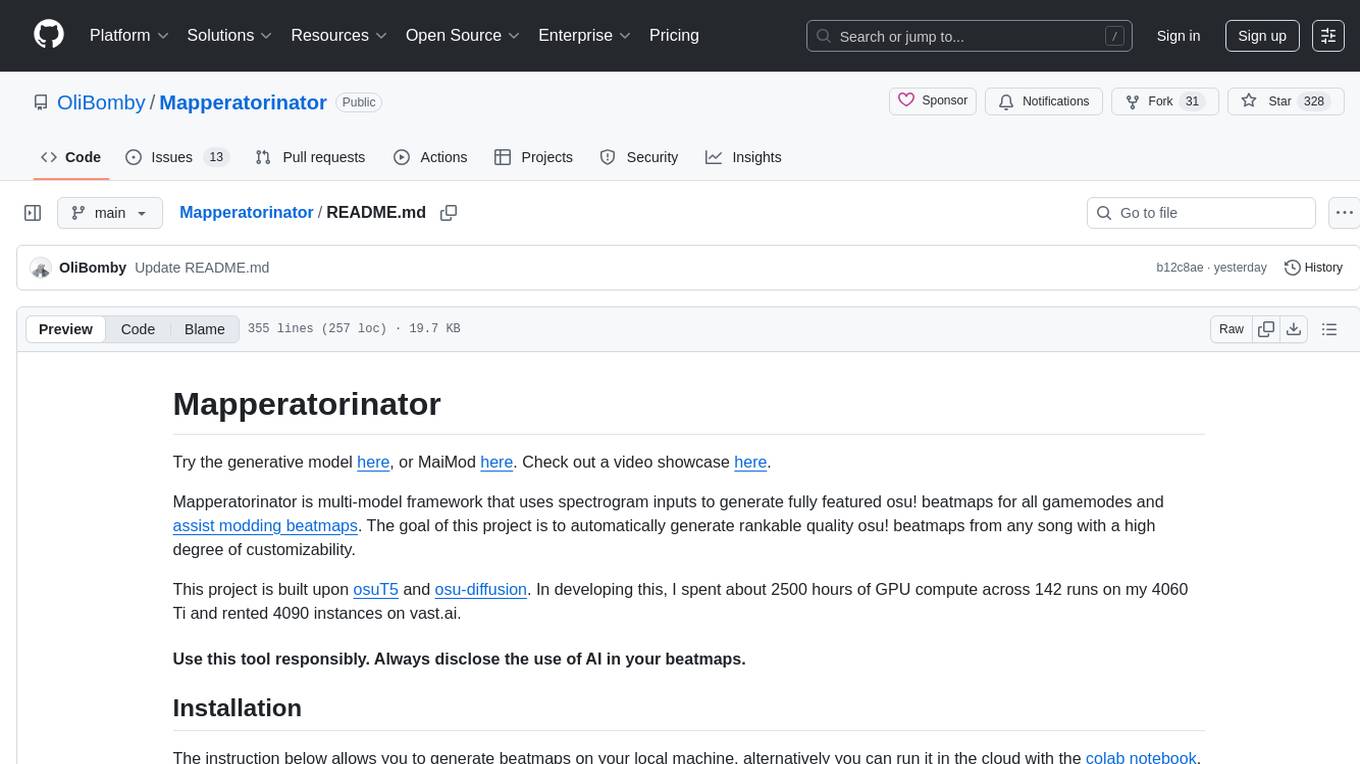
Mapperatorinator
Mapperatorinator is a multi-model framework that uses spectrogram inputs to generate fully featured osu! beatmaps for all gamemodes and assist modding beatmaps. The project aims to automatically generate rankable quality osu! beatmaps from any song with a high degree of customizability. The tool is built upon osuT5 and osu-diffusion, utilizing GPU compute and instances on vast.ai for development. Users can responsibly use AI in their beatmaps with this tool, ensuring disclosure of AI usage. Installation instructions include cloning the repository, creating a virtual environment, and installing dependencies. The tool offers a Web GUI for user-friendly experience and a Command-Line Inference option for advanced configurations. Additionally, an Interactive CLI script is available for terminal-based workflow with guided setup. The tool provides generation tips and features MaiMod, an AI-driven modding tool for osu! beatmaps. Mapperatorinator tokenizes beatmaps, utilizes a model architecture based on HF Transformers Whisper model, and offers multitask training format for conditional generation. The tool ensures seamless long generation, refines coordinates with diffusion, and performs post-processing for improved beatmap quality. Super timing generator enhances timing accuracy, and LoRA fine-tuning allows adaptation to specific styles or gamemodes. The project acknowledges credits and related works in the osu! community.
For similar tasks
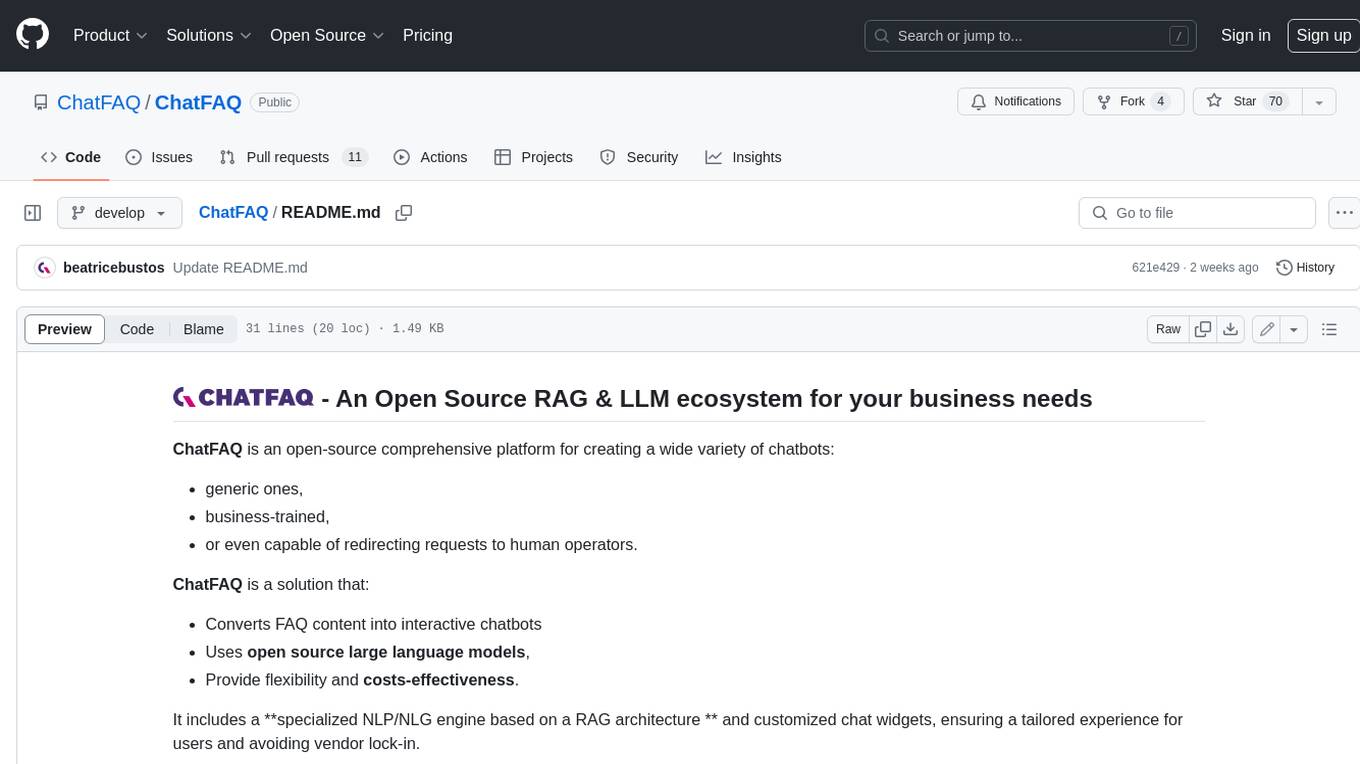
ChatFAQ
ChatFAQ is an open-source comprehensive platform for creating a wide variety of chatbots: generic ones, business-trained, or even capable of redirecting requests to human operators. It includes a specialized NLP/NLG engine based on a RAG architecture and customized chat widgets, ensuring a tailored experience for users and avoiding vendor lock-in.

teams-ai
The Teams AI Library is a software development kit (SDK) that helps developers create bots that can interact with Teams and Microsoft 365 applications. It is built on top of the Bot Framework SDK and simplifies the process of developing bots that interact with Teams' artificial intelligence capabilities. The SDK is available for JavaScript/TypeScript, .NET, and Python.

chatbot-ui
Chatbot UI is an open-source AI chat app that allows users to create and deploy their own AI chatbots. It is easy to use and can be customized to fit any need. Chatbot UI is perfect for businesses, developers, and anyone who wants to create a chatbot.
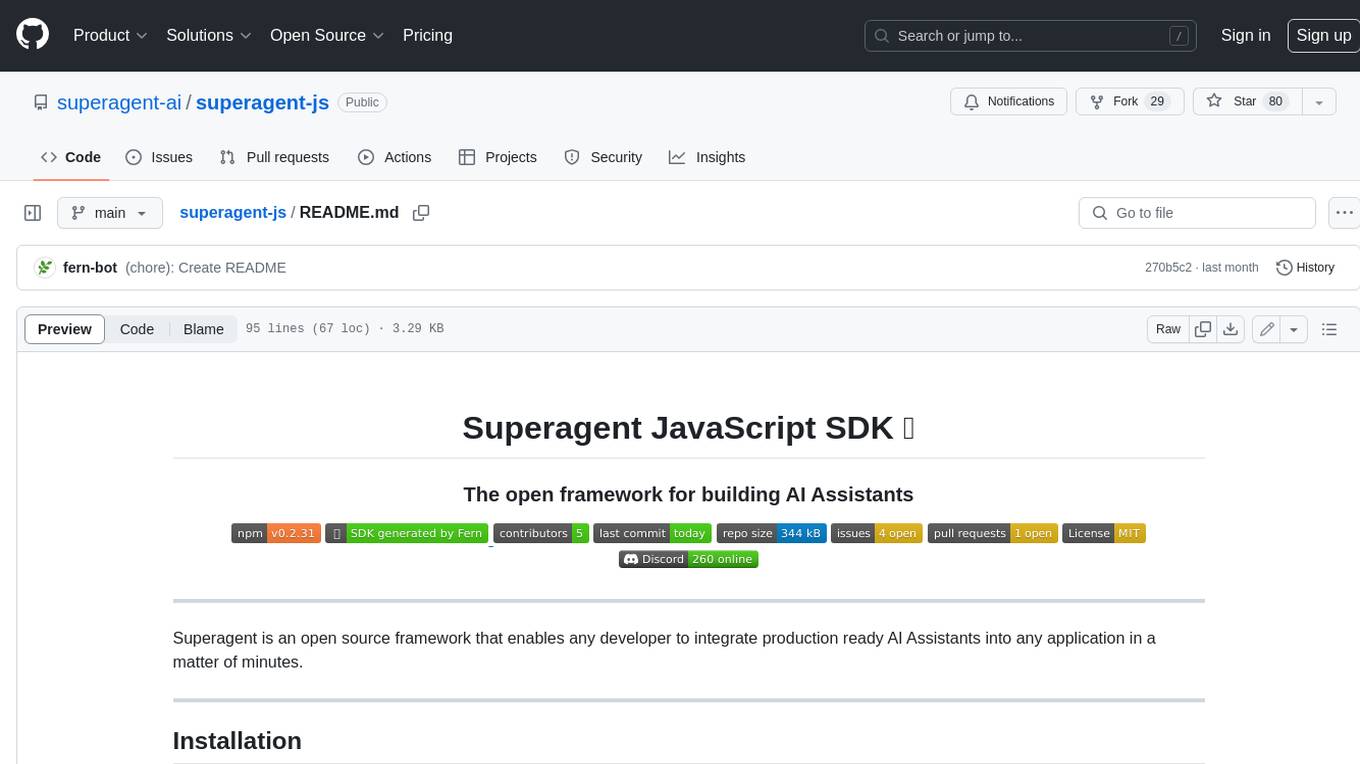
superagent-js
Superagent is an open source framework that enables any developer to integrate production ready AI Assistants into any application in a matter of minutes.
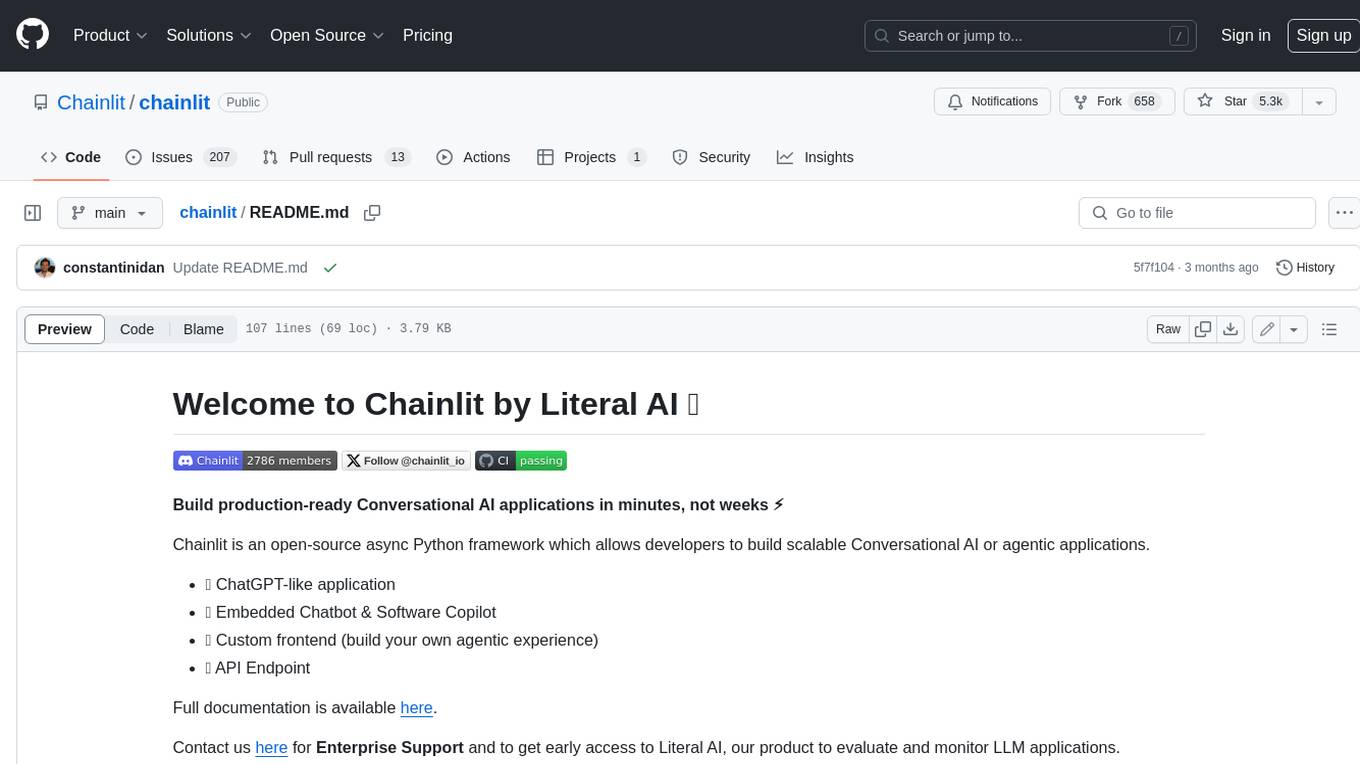
chainlit
Chainlit is an open-source async Python framework which allows developers to build scalable Conversational AI or agentic applications. It enables users to create ChatGPT-like applications, embedded chatbots, custom frontends, and API endpoints. The framework provides features such as multi-modal chats, chain of thought visualization, data persistence, human feedback, and an in-context prompt playground. Chainlit is compatible with various Python programs and libraries, including LangChain, Llama Index, Autogen, OpenAI Assistant, and Haystack. It offers a range of examples and a cookbook to showcase its capabilities and inspire users. Chainlit welcomes contributions and is licensed under the Apache 2.0 license.
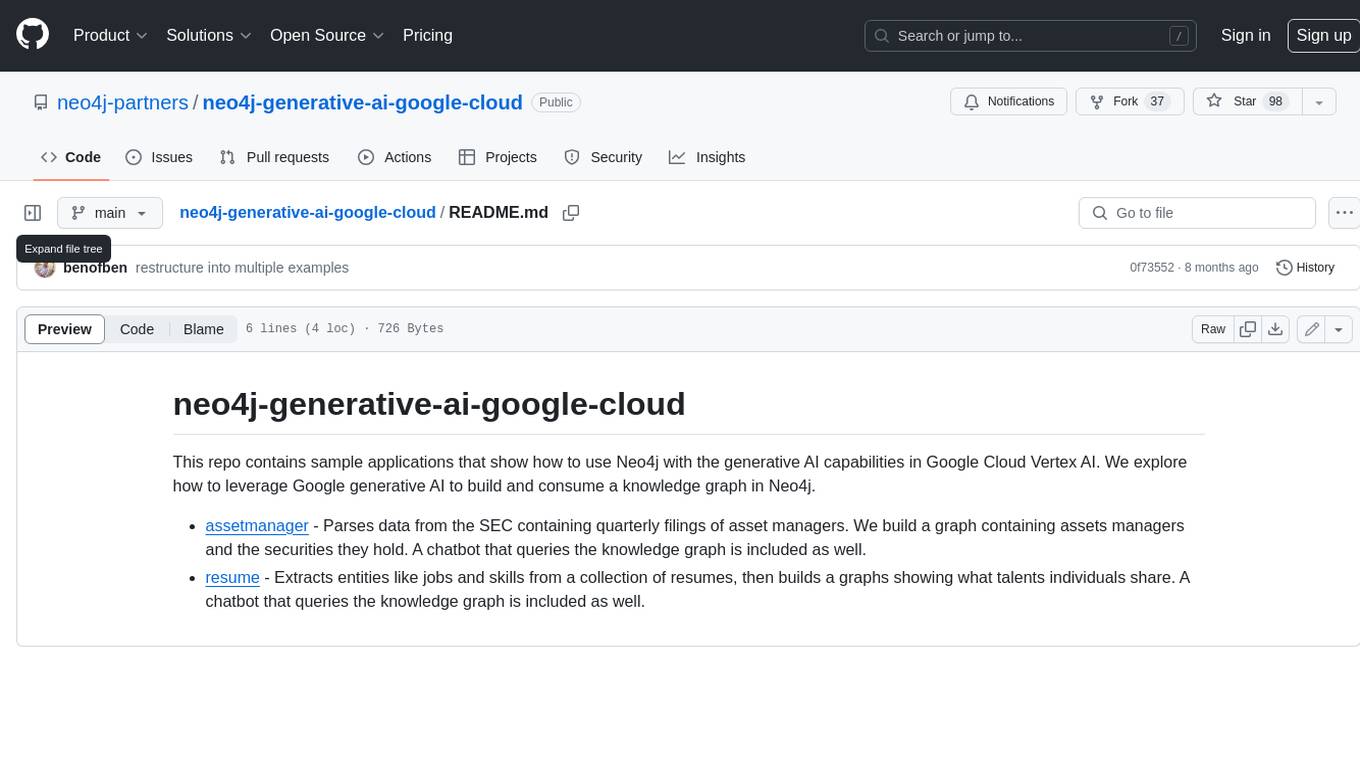
neo4j-generative-ai-google-cloud
This repo contains sample applications that show how to use Neo4j with the generative AI capabilities in Google Cloud Vertex AI. We explore how to leverage Google generative AI to build and consume a knowledge graph in Neo4j.
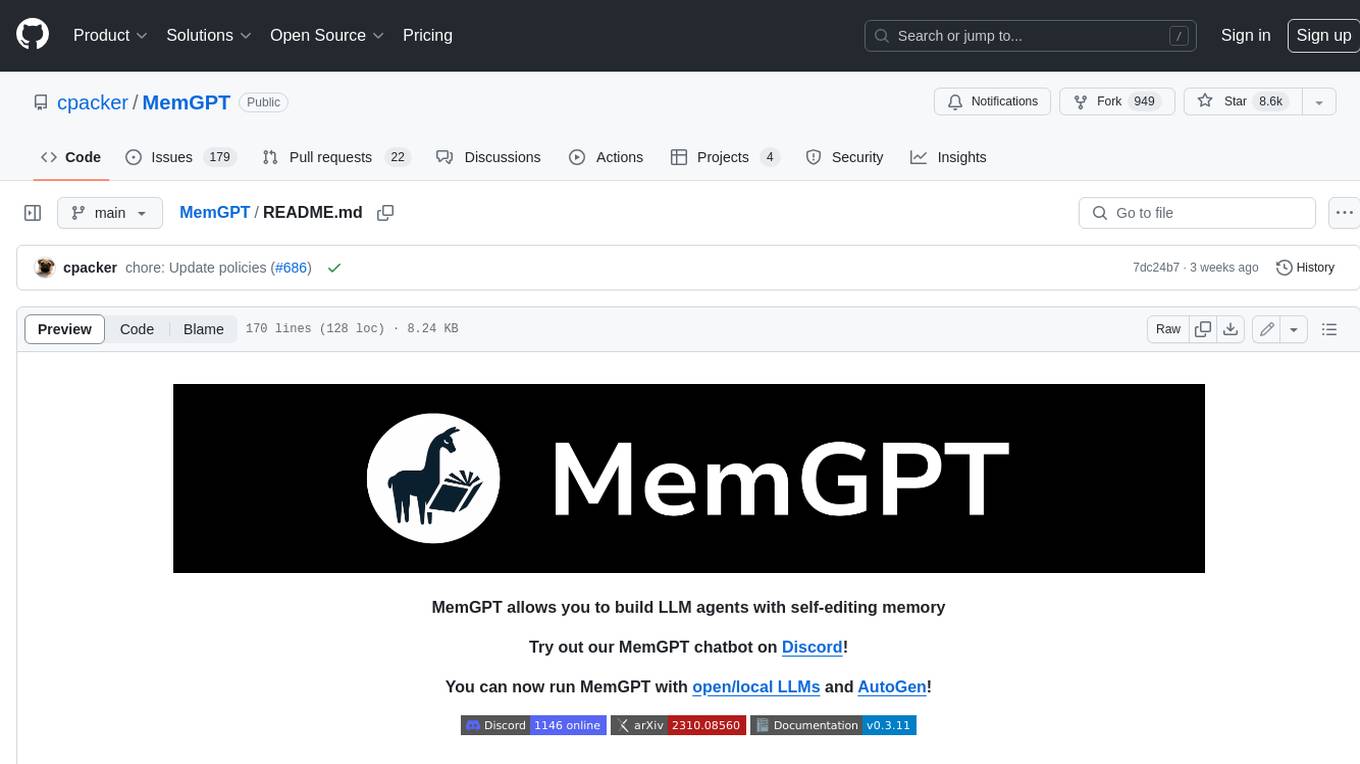
MemGPT
MemGPT is a system that intelligently manages different memory tiers in LLMs in order to effectively provide extended context within the LLM's limited context window. For example, MemGPT knows when to push critical information to a vector database and when to retrieve it later in the chat, enabling perpetual conversations. MemGPT can be used to create perpetual chatbots with self-editing memory, chat with your data by talking to your local files or SQL database, and more.
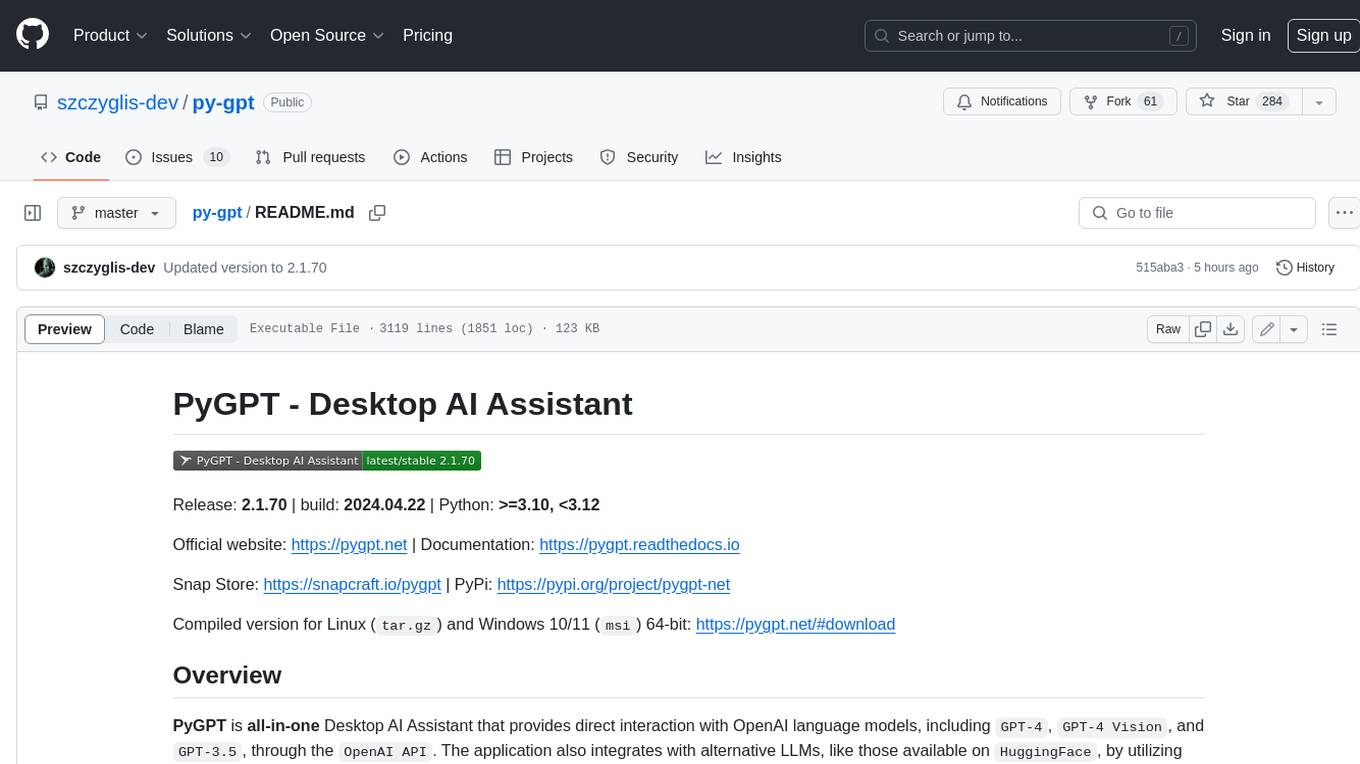
py-gpt
Py-GPT is a Python library that provides an easy-to-use interface for OpenAI's GPT-3 API. It allows users to interact with the powerful GPT-3 model for various natural language processing tasks. With Py-GPT, developers can quickly integrate GPT-3 capabilities into their applications, enabling them to generate text, answer questions, and more with just a few lines of code.
For similar jobs

weave
Weave is a toolkit for developing Generative AI applications, built by Weights & Biases. With Weave, you can log and debug language model inputs, outputs, and traces; build rigorous, apples-to-apples evaluations for language model use cases; and organize all the information generated across the LLM workflow, from experimentation to evaluations to production. Weave aims to bring rigor, best-practices, and composability to the inherently experimental process of developing Generative AI software, without introducing cognitive overhead.

LLMStack
LLMStack is a no-code platform for building generative AI agents, workflows, and chatbots. It allows users to connect their own data, internal tools, and GPT-powered models without any coding experience. LLMStack can be deployed to the cloud or on-premise and can be accessed via HTTP API or triggered from Slack or Discord.

VisionCraft
The VisionCraft API is a free API for using over 100 different AI models. From images to sound.

kaito
Kaito is an operator that automates the AI/ML inference model deployment in a Kubernetes cluster. It manages large model files using container images, avoids tuning deployment parameters to fit GPU hardware by providing preset configurations, auto-provisions GPU nodes based on model requirements, and hosts large model images in the public Microsoft Container Registry (MCR) if the license allows. Using Kaito, the workflow of onboarding large AI inference models in Kubernetes is largely simplified.

PyRIT
PyRIT is an open access automation framework designed to empower security professionals and ML engineers to red team foundation models and their applications. It automates AI Red Teaming tasks to allow operators to focus on more complicated and time-consuming tasks and can also identify security harms such as misuse (e.g., malware generation, jailbreaking), and privacy harms (e.g., identity theft). The goal is to allow researchers to have a baseline of how well their model and entire inference pipeline is doing against different harm categories and to be able to compare that baseline to future iterations of their model. This allows them to have empirical data on how well their model is doing today, and detect any degradation of performance based on future improvements.

tabby
Tabby is a self-hosted AI coding assistant, offering an open-source and on-premises alternative to GitHub Copilot. It boasts several key features: * Self-contained, with no need for a DBMS or cloud service. * OpenAPI interface, easy to integrate with existing infrastructure (e.g Cloud IDE). * Supports consumer-grade GPUs.

spear
SPEAR (Simulator for Photorealistic Embodied AI Research) is a powerful tool for training embodied agents. It features 300 unique virtual indoor environments with 2,566 unique rooms and 17,234 unique objects that can be manipulated individually. Each environment is designed by a professional artist and features detailed geometry, photorealistic materials, and a unique floor plan and object layout. SPEAR is implemented as Unreal Engine assets and provides an OpenAI Gym interface for interacting with the environments via Python.

Magick
Magick is a groundbreaking visual AIDE (Artificial Intelligence Development Environment) for no-code data pipelines and multimodal agents. Magick can connect to other services and comes with nodes and templates well-suited for intelligent agents, chatbots, complex reasoning systems and realistic characters.



